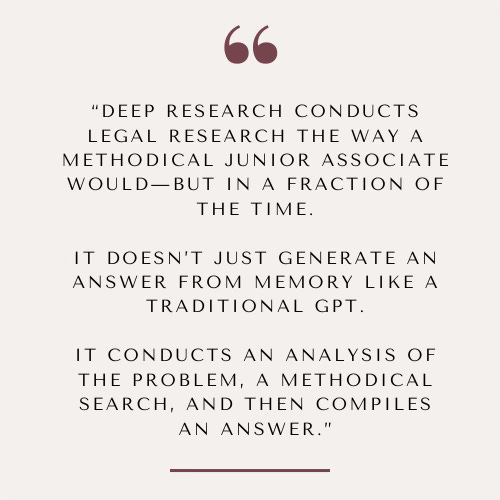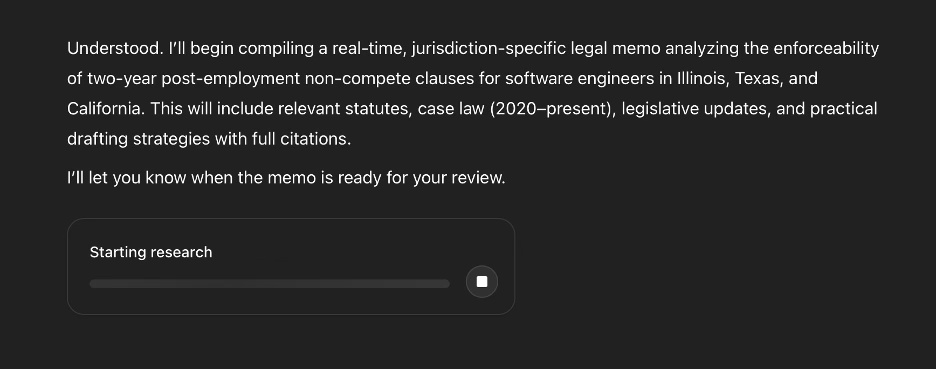My Deep Dive into 'Deep Research': What it Offers Lawyers and Legal Professionals
Stop Spending 6 Hours on Research that Could Take 20 Minutes
When you need a 50-state survey of non-compete law changes by tomorrow morning, you might log in to Westlaw® and settle in for a long night of research. OpenAI's Deep Research offers a different approach: an AI agent that can autonomously conduct multi-step legal research, synthesize authorities across jurisdictions, and return cited results in around 30 minutes. All packaged up into a memo and ready to go; you just need to verify the information in the memo.
Unlike ChatGPT and other conversational AI tools that generate responses from pre-trained knowledge, Deep Research uses an agentic framework to function more like a diligent junior associate—planning research strategies, systematically searching live sources, and building a comprehensive analysis with verifiable citations. For legal professionals drowning in information but starved for time, this represents a fundamental shift from AI as a drafting assistant to AI as a research partner.
This article explains what Deep Research is, how it differs from existing AI tools, and how lawyers can harness its capabilities while navigating its limitations. Whether you're conducting due diligence, tracking regulatory changes, or preparing complex research memos, understanding Deep Research's strengths and constraints will help you determine when this new tool belongs in your research workflow.
What is Deep Research?
Deep Research is OpenAI's AI agent that conducts legal research the way a methodical paralegal or associate would—but in a fraction of the time. When you give it a research question, it doesn't just generate an answer from memory like a typical chatbot, such as ChatGPT, Gemini or Claude would. Instead, it creates a research plan, systematically searches live legal databases and websites, evaluates sources, and synthesizes findings into a comprehensive report with citations you can verify.
How It Works:
Deep Research breaks complex legal questions into smaller research tasks, then executes them sequentially. For example, if you ask about multi-state employment law compliance, it might first search for recent federal developments, then systematically review state-by-state variations, cross-reference recent court decisions, and finally synthesize the findings into a coherent analysis—all while tracking sources and building citations. You can watch it “think” as it goes through these processes, talking to itself.
Key Differences Between Deep Research and Typical AI ChatBots
Although Deep Research is an OpenAI product and is accessed on the ChatGPT platform, there are a number of key differences between Deep Research and typical AI chatbots such as ChatGPT, Gemini, or Claude. The interesting thing is that Deep Research is an analytical model, and so has benefits that even legal-specific models like SpellBook don’t.
Some of the differences:
Live Research: Searches current legal databases instead of relying on training data
Multi-Step Process: Plans and executes research strategies rather than providing instant responses.
Verifiable Citations: Returns direct links to cases, statutes, and commentary, which increases accuracy and reduces hallucinations.
Time Investment: Takes 5-30+ minutes per query instead of seconds.
Why Deep Research Matters for Legal Professionals
Legal research continues to be a challenge. We continue to see firm after firm, lawyer after lawyer cite imaginary cases. Regulatory changes accelerate daily, case law multiplies across jurisdictions, and clients demand faster turnarounds while expecting the same thoroughness. Deep Research can help address these pressure points by automating the systematic, multi-source research that currently consumes hours of billable time. This approach dramatically reduces the hallucination risk that makes standard AI unreliable for legal work. Because Deep Research grounds every conclusion in cited sources, you get research that's both comprehensive and verifiable, essential for professional responsibility and client service standards.
How Deep Research Solves Real Legal Research Problems:
1. Handles Multi-Jurisdictional Research Projects When a client needs to understand how data privacy laws vary across all 50 states, Deep Research can systematically search state statutes, recent amendments, and enforcement guidance—then organize findings by jurisdiction. What typically requires days of manual research across multiple databases becomes a structured analysis completed in under an hour.
2. Provides Reliable, Verifiable Citations. Unlike ChatGPT, Gemini, or Claude, which may invent case citations, Deep Research nearly always returns direct links to actual court decisions, statutes, and regulatory guidance. Each citation connects to the live source, enabling immediate verification, critical for professional responsibility and court filings. Note, however, that it is not perfect. It’s still essential to keep a human in the loop to verify every citation.
3. Reduces Research Errors and Blind Spots. Deep Research systematically explores multiple angles of a legal question, reducing the risk of missing key authorities. Its methodical approach helps catch the outlier jurisdiction or recent development that might be overlooked in manual research, especially under time pressure.
4.Easier Prompting. As an analytical model, Deep Research will automatically approach every task by breaking it down into smaller steps or tasks, approach the task from different angles, and then do a real-time search. This simplifies prompts that would be required to get a traditional model to conduct the same procedures.
5. Better at Tracking Fast-Moving Legal Developments For areas like cryptocurrency regulation, AI governance, or pandemic-related legal changes, Deep Research can monitor multiple agencies, court systems, and legislative bodies simultaneously—ideal for keeping lawyers informed about rapidly evolving legal landscapes without constant manual monitoring.
Deep Research in Action: A Real World Example
To test it out, I gave Deep Research an assignment. Below is the prompt and the response I received:
Prompt: Prepare a memo (≈ 750 words) that answers the following question for a managing partner: Legal Question – Is a two-year, post-employment non-compete clause enforceable against software-engineer employees in Illinois, Texas, and California? Instructions Collect the most recent (2020 – present) appellate or supreme-court cases, plus any controlling statutes or regulations, from each state. Compare the standards each jurisdiction uses to determine reasonableness (scope, duration, geographic reach). Highlight any 2023-2025 legislative changes (e.g., Illinois FREEDOM-to-WORK Act amendments; California AB 1076). Identify practical drafting tips to improve enforceability in friendly jurisdictions and risk-mitigation strategies where clauses are disfavored. Cite every proposition with live links to the underlying authority (case reporter, statute, or official state site). Flag any unresolved splits or pending FTC rulemaking that might affect enforceability. Please include an Executive answer (≤ 250 words) State-by-state analysis table, Drafting / risk-management checklist, Full bibliography with URLs.
Its response:
Here is the Memo Deep Research prepared for me. I am not a subject matter expert or bar-licensed in these states; judge the Memo for yourself.
Use Cases and Effective Prompting
Modern legal workloads demand both precision and speed; the checklist below shows how to prompt Deep Research to meet those pain points. Deep Research is powerful, but not a panacea. It’s best use cases are:
Drafting research memos with real cases and statutes
Comparing contract clauses across jurisdictions
Identifying and summarizing regulatory updates
Preparing due diligence reports from public data
Tracking judge or opposing counsel patterns
Prompting Guidelines
Prompting techniques remain critical in using Deep Research, as with all GenAI tools. To get the most from Deep Research, follow these guidelines:
Be Specific
Poor: "Tell me about non-competes"
Better: "Find and summarize U.S. federal court decisions since 2020 on non-compete enforceability, with citations."
Best: See my prompt, above.
Include Context
Name statutes, parties, or jurisdictions if known.
Structure the Prompt
Use bullet points or numbered steps for complex tasks. Even though Deep Research will attack your prompts methodically, it is still more effective to break down larger tasks.
Allow Time
Responses can take up to around 30 minutes, or more; be patient.
Current Access and Limits
When I first started working on this article, OpenAI’s pricing structure was based on tiered access:
Pro users: 125 full queries/month + 125 lightweight
Plus, Team, Enterprise: 10 full + 15 lightweight
Free: 5 lightweight/month
The lightweight version uses a smaller model (o4-mini), and returns faster but shorter and less complete responses.
Check for updated pricing and usage information.
Best Practices for Lawyers Using Deep Research
We have unique obligations around competence, supervision, and confidentiality. Those obligations require specific protocols when using AI research tools. These best practices help you harness Deep Research's capabilities while maintaining professional standards and avoiding the pitfalls that have trapped other lawyers using AI.
I am a strong proponent of the trust-but-verify method of practicing law. That maxim holds true for Deep Research. Treat Deep Research outputs as sophisticated research memos from a junior associate—comprehensive starting points that require senior review. The AI provides the systematic legwork; you must still provide the legal judgment about relevance, weight, and application specific to your client's unique situation.
1. Always Verify Citations Independently Always. You don’t want to be the next “ChatGPT lawyer.” Deep Research significantly reduces hallucination risk, but that doesn’t mean you can get away without verifying all of its output. Professional responsibility requires independent verification. Before relying on any case, statute, or regulation, confirm it (and not just that it looks good). Check that cases haven't been overturned, distinguished, or superseded since the research was conducted.
2. Document Your Research Process Maintain records showing how you validated AI-generated research. This documentation could help protect you if questions arise about your research methodology. It also demonstrates reasonable professional diligence. Include dates of verification, databases checked, and any discrepancies found. And it doesn’t have to take a long time. It can be a task that you give to your GPT to track.
3. Start with Lower-Stakes Research Begin using Deep Research for background research, preliminary surveys, or internal analysis rather than case-critical court filings. Build familiarity with its strengths and limitations before relying on it for high-stakes matters.
4. Layer Your Research Tools Deep Research excels at broad, multi-jurisdictional surveys but may miss nuanced local practice or recent unpublished decisions. Complement it with specialized legal databases, or local bar resources or colleague consultation for comprehensive coverage.
5. Structure Complex Projects. For large research projects, break them into focused queries rather than one massive request. This improves accuracy and makes validation more manageable. For example, separate "federal law overview" from "state-by-state variations" rather than combining them.
6. Maintain Client Confidentiality Review your organization's AI use policies before inputting any client-specific information. Consider using hypothetical scenarios or anonymized fact patterns when possible. You can successfully use the client’s fact pattern without including their names or other specific personal information. Remember that Deep Research searches public sources—be careful when working with confidential information in your research queries.
7. Stay Within Your Competence Deep Research doesn't make you competent in unfamiliar practice areas. Use it to supplement your existing knowledge, not to venture into legal territory where you lack foundational understanding. The tool finds information—it doesn't provide the context needed for competent legal advice. This is why GenAI is not going to replace lawyers anytime soon.
8. Develop Transparent Billing Practices Establish clear policies about billing for AI-assisted research. Consider whether efficiency gains should benefit clients through reduced fees or faster turnaround rather than maintaining traditional hourly billing for research that now takes minutes instead of hours.
9. Inform Clients Appropriately While you're not required to disclose every research tool used, consider informing clients about your use of AI research assistance, especially for sophisticated clients who may have their own AI policies or preferences.
10. Regular Accuracy Audits Periodically conduct detailed verification of Deep Research outputs to monitor accuracy. This is in addition to verifying all output every time. Track any errors or limitations you discover to refine your validation process and identify when alternative research methods might be more appropriate.
11. Team Training and Supervision If you have newer associates or paralegals use Deep Research, ensure they understand how and when to use Deep Research, and these validation requirements. The supervising attorney remains responsible for the quality and accuracy of all research, regardless of the tools used to generate it.
Red Flags to Watch For
Be especially cautious when Deep Research returns:
Citations that seem too perfect or convenient
Results that contradict your understanding of settled law
Research on rapidly changing regulatory areas
Analysis of local rules or specialized practice areas
Conclusions that would significantly impact client strategy
In these situations, conduct extra verification or consider alternative research approaches. Always Use GenAI to Augment, not Substitute for legal judgment.
Takeaway: Deep Research offers the broadest fact‑finding reach, whereas legal‑specific platforms provide turnkey workflows on proprietary databases. Most firms benefit from a layered strategy that uses each tool for what it does best.
Conclusion
Deep Research represents a fundamental shift in legal research, from AI as a drafting assistant to AI as a research partner. For lawyers facing increasing information complexity and client demands for faster turnarounds, it offers a way to maintain thoroughness while dramatically reducing research time.
The key to success with Deep Research lies in understanding its role in your research workflow. Use it to handle the systematic, multi-source research that currently consumes hours of associate time. Let it identify the key authorities, track developments across jurisdictions, and provide the cited foundation for your analysis. But always remember: Deep Research finds and organizes information—the legal judgment, strategy, and client counseling remain uniquely yours.
As legal practice continues evolving under pressure from technology and client expectations, tools like Deep Research don't replace lawyer expertise—they amplify it. The lawyers who thrive will be those who learn to direct AI research agents effectively while maintaining the professional standards and strategic thinking that define excellent legal representation.
© 2025 Amy Swaner. All Rights Reserved. May use with attribution and link to article.







